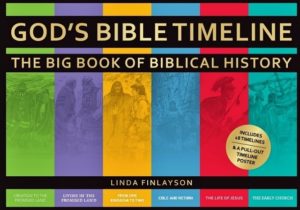 In a previous post Linda Finlayson’s God’s Timeline: The Big Book of Church History, Christian Focus, 2018, was reviewed, and now she has used her gifts for simplicity, clarity, aesthetics, and organization to address the problem of Biblical illiteracy by beginning with children. In recent decades lack of Bible knowledge among conservative-confessional Presbyterians is common, so much so that sessions, presbyteries, and general assemblies have adopted Bible knowledge requirements for church-office candidates and in some cases remedial English Bible instruction has been added to theological seminary curriculums. It is sad that the ready availability of God’s vernacular Word has not yielded a comparable abundance of Bible literacy. Evangelicals have taken proper pride in their Bibles, but unfortunately as the years have passed doctrinal disinterest has had its effect on attitudes toward the Bible. If doctrine does not matter, then why would its source be so important? The Bereans (Acts 17:10-11), seekers of Truth (John 17:17), and pilgrims on the dimly lit path (Psalm 119:105) should encourage Christians today to read and know their Bibles. But there is a problem—the Bible is a very large book. How does one approach its sixty-six books, hundreds of chapters, and thousands of verses? Linda Finlayson has provided a helpful and simple tool in God’s Bible Timeline: The Big Book of Biblical History.
In a previous post Linda Finlayson’s God’s Timeline: The Big Book of Church History, Christian Focus, 2018, was reviewed, and now she has used her gifts for simplicity, clarity, aesthetics, and organization to address the problem of Biblical illiteracy by beginning with children. In recent decades lack of Bible knowledge among conservative-confessional Presbyterians is common, so much so that sessions, presbyteries, and general assemblies have adopted Bible knowledge requirements for church-office candidates and in some cases remedial English Bible instruction has been added to theological seminary curriculums. It is sad that the ready availability of God’s vernacular Word has not yielded a comparable abundance of Bible literacy. Evangelicals have taken proper pride in their Bibles, but unfortunately as the years have passed doctrinal disinterest has had its effect on attitudes toward the Bible. If doctrine does not matter, then why would its source be so important? The Bereans (Acts 17:10-11), seekers of Truth (John 17:17), and pilgrims on the dimly lit path (Psalm 119:105) should encourage Christians today to read and know their Bibles. But there is a problem—the Bible is a very large book. How does one approach its sixty-six books, hundreds of chapters, and thousands of verses? Linda Finlayson has provided a helpful and simple tool in God’s Bible Timeline: The Big Book of Biblical History.
The attractive cover design of The Big Book of Church History has been adapted for the Big Book of Biblical History with some enhancing changes. The use of black trim and the gold-film seal announcing 18 timelines and a pull-out poster are pleasing. The book includes six color-coded epochs of Bible history—“Creation to the Promised Land,” “Living in the Promised Land,” “From One Kingdom to Two,” “Exile to Return,” “The Messiah,” and “The Early Church.” Care was used to show in each section of the timeline the unfolding of the Covenant of Grace. Interspersed among the timeline slices are portions of text explaining things such as “Who Are the Patriarchs?,” “Welcome to the Exile,” and “How the Passover became the Lord’s Supper.” Woven into the progression through Scripture’s events are key political, social, and catastrophic occurrences. For example, the intertestamental period includes Alexander the Great, the Egyptian Ptolemaic Empire, translation of the Septuagint—Greek edition of the Old Testament, and the burning of the great library in Alexandria. The chronology is colorful, clearly communicated, and cogently composed from a variety of valued sources including the wisdom of experts in their fields. A bibliography, image index crediting the sources of the illustrations, and a two-leaf comprehensive timeline conclude the book. The timeline ends at A.D. 70 presumably because of the destruction of Jerusalem and the associated completion of the composition of the New Testament books by their inspired authors by that year. A ribbon marker is included for convenience.
The book is designed for children whether it is read to, with, or by a child. The colorful visual aspects and brevity of words combine to appeal to youngsters. Possibly the most important educator in American history was John Witherspoon who understood the necessity of training children at a young age.
Only observe, that the importance of early instruction is written upon the whole system of nature, and repeated in every page of the history of Providence. You may bend a young twig and make it receive almost any form; but that which has attained to maturity, and taken its ply, you will never bring into another shape than that which it naturally bears. In the same manner those habits which men contract in early life, and are strengthened by time, it is next to impossible to change.
Resolving the problem of unfamiliarity with God’s Word among adults begins with instruction of the young. Reformed people, as they should, emphasize the importance of catechizing children with doctrine, but have catechisms been used at the expense of simple training in the content and continuity of the Bible? Reformed people know Scripture is unified by the Covenant of Grace and it is important to understand the overall picture of what God has revealed from Genesis through Revelation. Linda Finlayson’s God’s Bible Timeline: The Big Book of Biblical History provides a forest view of the Bible while explaining the importance of its individual trees of people, events, places and topics.
Barry Waugh





